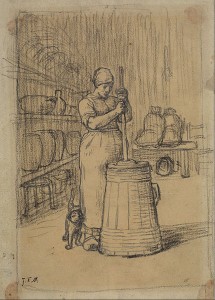I went to Europe for the first time when I was 19. It was there that I discovered two food products. The first was disgusting white, greasy glob that the purveyors identified as margarine. This was a revelation to me since U.S. margarine was infused with some sort of yellow food coloring. The moment I saw margarine in its “natural” state, I struck it off my list of condiments.
The second product was margarine’s extreme opposite. Butter. Real Butter. Real Butter that must have had a touch of cream in it. I liked Dutch butter best. My love affair with butter continued through all nutritional warnings. As the Handsome Bloke observes, I like to have a bit of bread with my butter.
Saturday my my butter addiction was vindicated. NPR ran a story by Allison Aubrey. Her opening line: “There’s a growing number of Americans who seem to believe that everything is better with butter.” To which I replied, “Eureka!” Don’t worry, I knew she couldn’t hear me.
But how did butter get such a bad rap in the first place? And how has the succulent fat been rehabilitated? Once upon a time science told us all cholesterol was bad. Fat was the enemy. Eat fish. Take the skin off the chicken. Replace whole milk with skim. (I still remember skim milk’s eery white color and the bluish ring at the edges.) And, never, ever use butter. Don’t cook with it. Don’t eat it. Don’t buy it. Egg yolks and red meat were also suspect. And don’t even think about pork, now known as the “other white meat.”

Life and this blog are too short to talk about the ever-changing world of nutrition, so let’s get back to our original subject. Butter. What happened when Americans swore off butter? They still wanted something butter-like to spread on their bread. Fortunately, there was another product waiting in the wings. Margarine — a product the dairy industry had been fighting since it was introduced to the public in 1874. Originally made from beef fat, the product was cheaper than dairy butter and sold well. The dairy industry argued that consumers wouldn’t be able to differentiate between the two products. This led to the Federal Margarine Act of 1886 to require labeling. Enforcement proved elusive.
In the early twentieth century, vegetable oil replaced beef fat as the primary ingredient in margarine. This produced a naturally white product, easily identifiable to consumers. Manufacturers who used yellow food coloring had to pay extra tax. Many producers included a pack of yellow coloring housewives could mix into the product to disguise its natural appearance. In 1950 President Truman signed the Margarine Law which ended the tax on colored margarine. Shortly thereafter, Americans, however reluctantly, changed their diet. Butter Bad – Vegetable Oil/Margarine good. Simple enough.
Except at room temperature, oil has a liquid consistency. You might think that marketers could simply educate Americans on the benefits of olive oil — but that was too far out of the box. Processors came up with a method to hydrogenate the vegetable oil to a harder consistency resembling room temperature butter, with the added bonus of a longer shelf life. (Remember, refrigerators were smaller then. People kept butter and bread on the countertop.) During the hydrogenation process, liquid vegetable oil gathers transfat — which we now know increases bad cholesterol and lowers good cholesterol.
Oops. Don’t you hate it when you try to do things right, and it comes out wrong? I mean, Americans were giving up all sorts of flavor, and still ingesting bad things.
Margarine changed over the years. Today there are margarines containing zero transfat, low saturated fat, and high unsaturated fat. One or more producers have taken the process a step further by adding a “drop” of butter to their formula. Check the labels for full disclosure.
Meanwhile, Allison Aubrey reported that, despite the presence of saturated fat, American butter consumption is up 40 percent. Vive la différence!
Acknowledgements:
Featured Image: Photo of Butter Stick by Author.
Allison Aubrey. “Better With Butter? Here’s Why Americans Are Consuming More.” Sept. 6, 2014. Access here.
Kris Gunnars. “Butter vs Margarine – Why I Trust Cows More Than Chemists.” Authority Nutrition. Access here.
Jan Sheehan. “Butter Vs. No-Trans-Fat Margarine.” SFGate. Access here.
Adam Young. “The War on Margarine.” The Freeman. Access here.

Sandra Wagner-Wright holds the doctoral degree in history and taught women’s and global history at the University of Hawai`i. Sandra travels for her research, most recently to Salem, Massachusetts, the setting of her new Salem Stories series. She also enjoys traveling for new experiences. Recent trips include Antarctica and a river cruise on the Rhine from Amsterdam to Basel.
Sandra particularly likes writing about strong women who make a difference. She lives in Hilo, Hawai`i with her family and writes a blog relating to history, travel, and the idiosyncrasies of life.


I’ve never believed that butter was bad for you. I thank you for this article. Loved it. I never stopped eating butter….but moderately!!!/
Mahalo! xoxoxodk
If we wait long enough, everything advertised as “bad” becomes good and vice versa. Thanks for commenting.